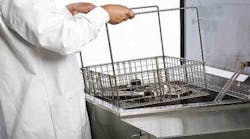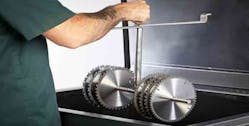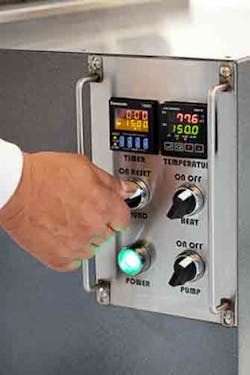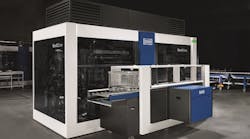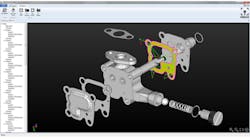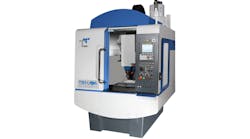The cost of cleanliness is no small matter in manufacturing. Manufacturers need to budget for cleaning equipment, chemicals, cleaning staff and, of course, the water and electricity needed to uphold the high standards of component cleanliness. Many manufacturers find themselves overpaying for cleaning options, especially in a world of high-volume and low mass.
There are plenty of cost-reducing alternatives for today’s manufacturers, offering a boost in efficiency and reduction of cost. The primary alternative is ultrasonic cleaning, already well established as a revolutionary alternative to complex, solvent-dependent cleaning processes. Rather than relying on toxic and expensive solvents, ultrasonic cleaners incorporate inexpensive, environmentally friendly detergents and consume low levels of water and power.
By using gentle, yet effective, sound waves to clean a variety of parts, ultrasonic cleaners can save manufacturers thousands of dollars annually simply by way of their efficiency.
Historically, cleaning processes have required a team of workers trained to clean industrial components safely. Conventional approaches dictated that more detailed or complex parts require greater skill to clean properly. Factoring the numbers associated with hiring, training, and supplying a full team of skilled cleaners, not to mention the potential medical costs if team members are exposed to toxic solvents, the financial loss can be daunting.
On the other hand, ultrasonic cleaners require no toxic solvents and are controlled from a single time and temperature regulation unit. Depending on the size of the load, only one person is needed to transfer parts, input the cleaning settings, and remove the parts from the ultrasonic bath. One or two more may assist with unpacking, rinsing, and/or drying, and minimal training is required to make this an efficient process.
Some manufacturers make the mistake of buying beyond their needs. For example, many ultrasonic cleaning system suppliers offer a variety of accessories to enhance their machines, such as optional tank covers and additional baskets for contents.
Larger, multi-stage cleaners even offer full automation of their system with conveyer belts to move parts between tanks. This may be very useful for high-volume cleanings, but for lower volume or lower frequency cleanings, full automation is an unnecessary expense. In fact, by choosing manual over automatic cleaners, manufacturers may save 30-50% on equipment and maintenance costs.
Four on the Floor, or Table
Another common mistake that manufacturers make when choosing an ultrasonic cleaning system is going for full power when full power isn’t necessary. This may generate several problems, from wasted capital expense to damaged parts. If power level 2 will get the job done right, then there’s no reason to invest in an ultrasonic cleaner that goes up to power level 10, just because it can. Taking into account a company’s actual cleaning requirements can mean considerable savings to the manufacturer.
There are four distinct categories of ultrasonic cleaners for manufacturers to choose: tabletop, benchtop, floor model, and multi-stage cleaner. The tabletop cleaner, of course, fits on any table or countertop and is appropriate for casual and low-volume cleaners.
Benchtop cleaners jump up one size for larger parts and larger loads, and tend to be stronger than tabletop cleaners.
Floor models cover the range of industrial cleaning tasks, and may be combined into a multi-stage system that incorporate a wash tank, rinse area, and drying chamber. Each has its signature strength for certain loads, but when it comes to cutting costs, there are a few tricks to learn.
Without a doubt, individual, single-batch floor model systems are the most expensive options. While there is little difference in monetary cost between floor models and multi-stage cleaning systems, floor models simply wash, whereas multi-stage cleaning systems incorporate washing, rinsing, and drying into one system. For large-scale cleanups, large mechanical parts or disaster recovery, the multi-stage cleaning system will perform most effectively in the least time. Time saved leads to savings on the bottom line as well.
Low-volume and small part manufacturers may not need the vast capacity of a floor model or multi-stage cleaning system. In fact, it may be easier to damage or lose the parts in a larger model, not to mention the wasted space. It is critical for manufacturers to choose a cleaning option that effectively fits their specific cleaning needs without overbuying. This is where creativity comes into play.
Rather than go through the time-consuming and energy-intensive process of customizing a floor model or a multi-stage batch system, it is possible for manufacturers with lower cleaning volume to substitute smaller models while retaining efficiency. There is no need to invest in a disproportionately large cleaning system if the parts being cleaned are uniformly small in size and volume. Therefore attention should be paid to the smaller options.
Tabletop and benchtop cleaners are produced in bulk and are therefore considerably more affordable than their larger, customizable counterparts. This provides manufacturers with an off-the-shelf solution without the hassle of customizing an entire workplace to accommodate small parts.
Tabletop cleaners offer nearly infinite flexibility for designing a workspace, while benchtop cleaners are stronger and can accommodate larger volumes of parts. Both types of portable units can be used throughout a shop to create, in effect, an affordable multi-stage batch system.
Ultrasonic cleaners have revolutionized cleaning, from large-scale disaster restorations to meeting high standards of cleanliness for smaller components. In addition to reducing cleaning time and work hazards for cleaning teams, making the switch to ultrasonic cleaners has proven to be an effective approach for cost cutting in manufacturing.
It is, of course, critical for manufacturers to do their research before investing, in order to avoid “overbuying” based on accessories or capacity beyond the company’s needs. Once the proper choice has been made among the tabletop, benchtop, floor model, and multi-stage cleaning systems, manufacturers can prepare to enjoy highly effective cleaning and saving operating costs for years to come.
Frank Pedeflous is the president of Omegasonics. Contact him at [email protected] or 1.888.989.5560.
